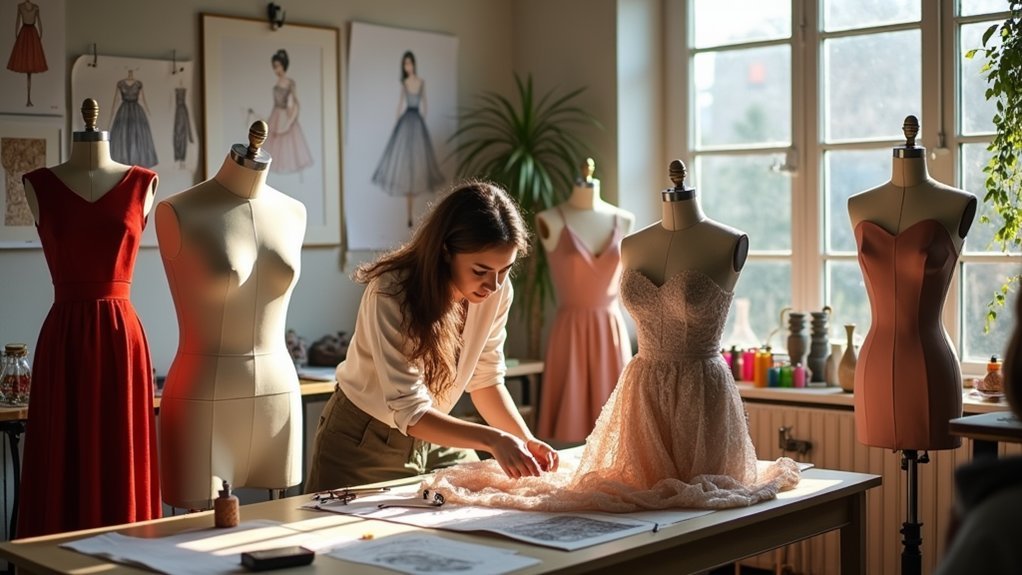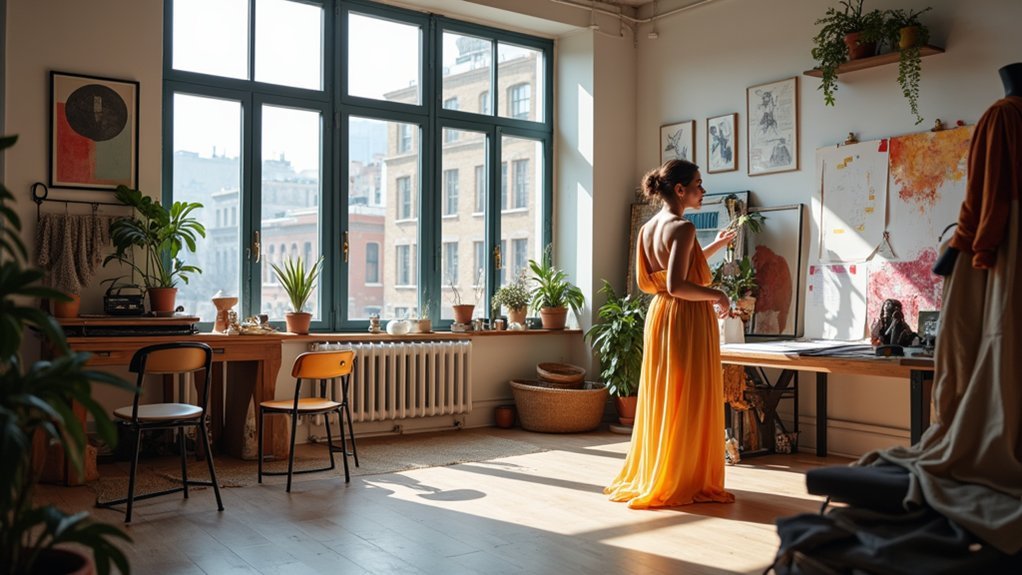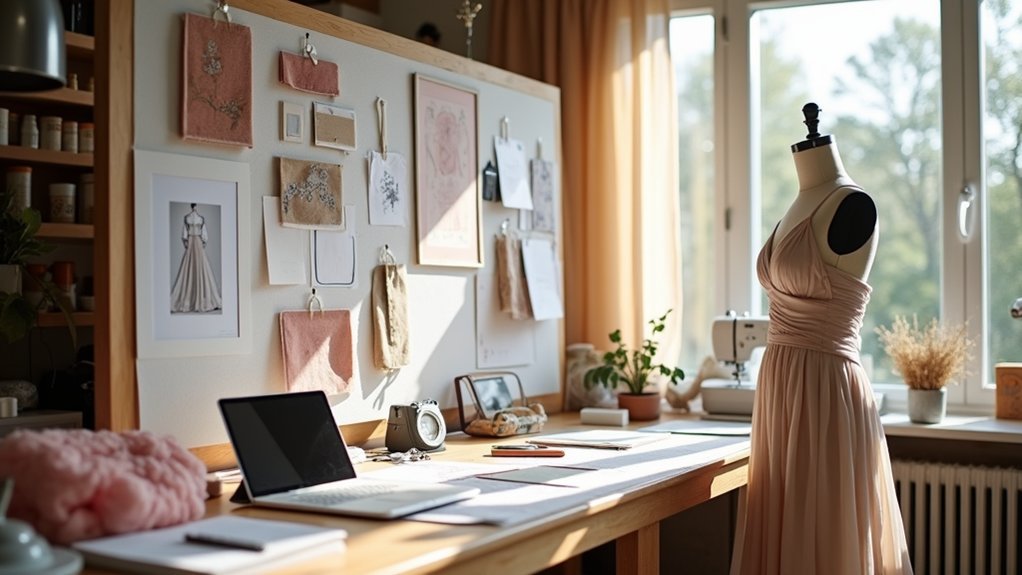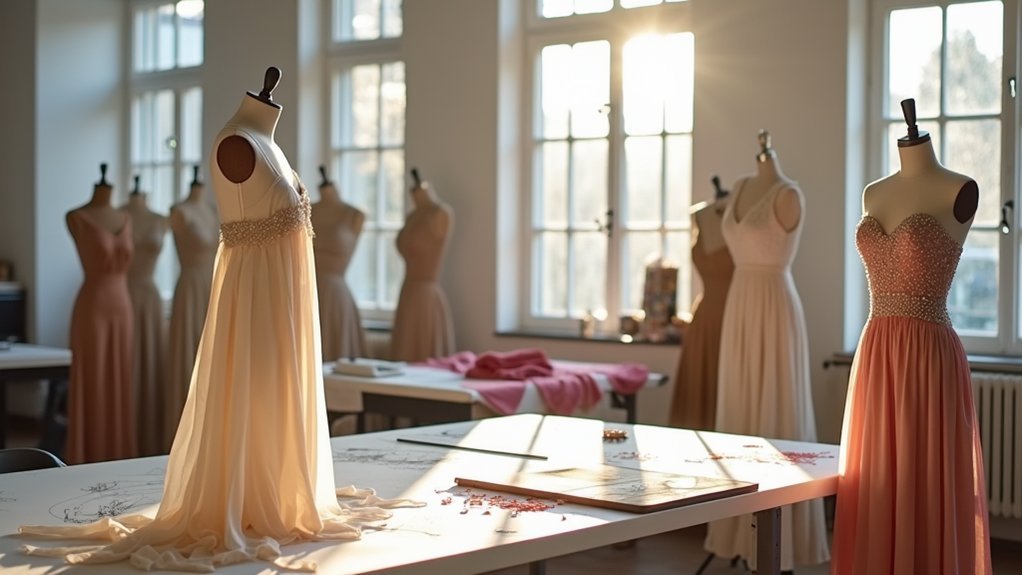Fashion design offers creative and dynamic opportunities for those passionate about clothing and accessories. In spite of the competitive nature and limited growth, the industry is constantly changing with trends like sustainability and wearable technology. A bachelor's degree and technical skills are crucial, as well as networking and continuous learning improving career prospects. Salaries average around $74,410, with potential for higher earnings in certain sectors. Exploring this path further reveals myriad possibilities for career advancement and personal fulfillment.
Key Takeaways
- Fashion design offers creative freedom with opportunities in high fashion, retail, and bespoke design sectors.
- The industry faces intense competition but provides dynamic career growth, particularly in major fashion hubs.
- Sustainability practices and digital innovation are reshaping industry trends, offering new opportunities for designers.
- A bachelor's degree, strong portfolio, and industry certifications significantly enhance career prospects.
- Potential for specialization and entrepreneurship allows for flexibility and higher earning potential within the industry.
Is Fashion Design a Good Career Path? Let's Explore

A career in fashion design involves a blend of creativity and technical skills, as designers create clothing, accessories, and footwear that align with current trends. Fashion designers often work in diverse industry areas, from high street fashion to bespoke designs, and may choose to specialize in areas like costume design or fashion styling. The profession requires a strong educational background, typically a Bachelor's degree, alongside key skills such as sewing, pattern making, and a comprehension of business and marketing to succeed in a competitive market. The fashion industry shapes cultural trends and personal expression, with major fashion shows and events showcasing designer visions and trends. With flexible work hours and the potential for freelance or part-time positions, fashion designing offers a unique blend of creativity and adaptability in the professional world. According to employment statistics, the employment growth for fashion designers in the US is projected at 2.7% for 2024, indicating a positive outlook for those considering a career in this field. Despite the glamour associated with the industry, career prospects for fashion designers remain challenging, with limited job growth and high competition.
What does a career in Fashion Design involve?
A career in fashion design involves a range of responsibilities, including researching current trends to inspire new designs and working collaboratively with other industry professionals to bring these ideas to fruition. Success in this field requires a strong foundation in design principles and technical skills, such as proficiency with digital tools and a thorough comprehension of textiles and garment construction. Moreover, aspiring designers should possess effective communication and collaboration skills, enabling them to work well within teams and adapt to the dynamic demands of the fashion industry. Fashion designers often work in comfortable office settings but may need to travel extensively to attend trade shows and meet suppliers. Additionally, most fashion designers hold a bachelor's degree, which provides them with the foundational knowledge necessary to excel in this creative and competitive field. Many designers aim to have their own fashion brand, which is often a challenging and time-consuming endeavor.
Common responsibilities in Fashion Design
Starting a career in fashion design involves honing a diverse set of responsibilities that blend creativity with practical skills.
Professionals must navigate:
- Design Process: Ensuring that design ethics and sustainable practices are integral when creating and producing fashion items. Using computer-aided design (CAD) programs is often essential to accurately visualize and develop designs effectively.
- Collaborative Efforts: Engaging in communication with teams to develop cohesive collections. Fashion designers are often responsible for ensuring production processes adhere to design specifications.
- Market Alignment: Continually aligning fashion trends with consumer demand and business strategies for success.
Required skills for success
Fashion design professionals take on a broad range of responsibilities that mix artistry with practical skills, setting the stage for a rewarding career. Creativity plays a vital role, inspired by creative influences that fuel innovation. Additionally, as sustainability is seen as the future of the fashion industry, designers are increasingly focusing on eco-friendly practices. Designers now influence the future through sustainable practices and advanced technologies. Skill development in artistic and technical areas such as sketching, pattern-making, and CAD is essential. Good communication skills are critical for effectively conveying design expectations and coordinating with team members. Designers often oversee production processes to ensure quality standards are met. Business acumen, including target market analysis and financial management, further improves a designer's success.
Is There Demand for Fashion Design Professionals?
The demand for fashion design professionals is shaped by a growing global apparel market, valued at approximately $1.7 trillion in 2023, and the industry's expansion in sectors beyond traditional fashion. Employment trends project a 5% growth for fashion designers from 2023 to 2033, indicating steady job opportunities across various sectors such as retail, manufacturing, and even self-employment. The allure of fashion design lies in its ability to allow for continuous experimentation, where designers can express and convey messages through their work, thus making it an attractive field for creative expression. With an 82.7% female demographic, the fashion design industry is notably female-dominated. With approximately 2,500 job openings annually through 2030, the industry provides a dynamic environment for aspiring designers. With additional career paths in fashion marketing and merchandising, the industry offers diverse opportunities for designers, reflecting a stable demand for skilled talent in both local and international markets.
Industry trends shaping Fashion Design careers
As the fashion industry embraces transformative trends, the demand for fashion design professionals is evolving in exciting new directions. The focus on sustainable fashion has led to innovative practices, such as using organic cotton and recycled fabrics. Digital innovation is another vital trend, reshaping marketing and consumption through social commerce and online platforms. The rapid integration of technology in fashion has also set the stage for future developments in wearable technology, further expanding the scope of opportunities in the industry. With trends like Boho Chic in Suede projected to grow significantly, designers have more room to creatively explore new materials and styles. The integration of technology in fashion has paved the way for:
- AI in Design: AI-generated designs allow for unique and personal customization in clothing.
- Innovative Textiles: New textile technologies enable garments with advanced features like moisture-wicking properties.
- Metaverse Experiences: VR and the metaverse are creating immersive brand experiences that improve consumer interaction.
Brands are increasingly leveraging social commerce opportunities, creating a new sales channel that has become instrumental in digital marketing strategies. These trends are influencing fashion design careers, providing new opportunities and challenges for professionals in the field.
Job market outlook for Fashion Design
A variety of factors contribute to the job market outlook for fashion design professionals. Even though the job growth for fashion designers is projected at 3% from 2016 to 2026, slower than the average for all occupations, there are over 49,476 active job openings in the U.S. For those interested in a career in the industry, opportunities in banking could provide transferable skills. Industry challenges include the decline in apparel manufacturing, which is expected to decrease by 33%. On the other hand, job opportunities in the retail trade industry are set to grow by 22%. Digital proficiency and experience are critical in this competitive field. Fashion designer jobs are steadily increasing, and there were 4,202 job openings recorded in 2020. Prospective designers often find employment concentrated in major regions like New York and California.
| Aspect | Trend | Impact |
|---|---|---|
| Job Growth | 3% increase | Limited expansion |
| New Jobs | 700 estimated | Few additions |
| Apparel Manufacturing | 33% decline | Decreased positions |
| Retail Trade | 22% growth | More opportunities |
| Location | NY and CA | Concentration of jobs |
Benefits of Working in Fashion Design

Fashion design attracts many individuals because of its unique blend of creative expression and entrepreneurial opportunity. The field allows designers to bring their artistic visions to life as they potentially impact fashion trends on a global scale.
Furthermore, the diverse specializations and dynamic nature of the industry provide numerous paths for career growth and personal fulfillment.
Why people choose Fashion Design as a career
Fashion design offers numerous benefits, attracting many to choose it as a career.
The field provides a platform for creative freedom and innovation, allowing designers to influence global trends and express artistic ideas through fashion.
Furthermore, it promises long-term growth potential, with diverse career opportunities and the chance to thrive in a fast-growing market.
Key advantages of working in Fashion Design
Working in fashion design offers numerous advantages that attract many individuals to pursue this creative career path. It provides innovative opportunities such as:
- Creative Expression and Innovation: Designers influence and narrate cultural stories through sustainable fashion.
- Career Diversity and Versatility: Specializations abound from haute couture to freelancing, enhancing personal growth.
- Global Impact and Recognition: Designers can gain international recognition and promote cultural exchange.
Long-term growth potential
The growth potential in fashion design is a compelling aspect that attracts many to this dynamic field.
With the global apparel market broadening, opportunities to shape market trends are abundant. The industry's evolution in the direction of a sustainability focus improves its long-term promise, providing designers a platform to innovate.
As demand for eco-friendly creations rises, fashion design offers significant room for those seeking impactful careers.
Challenges of a Career in Fashion Design
The fashion design industry is fraught with challenges that can make a career in this field demanding. Professionals often confront a talent deficit, intense competition, and pressures to embrace sustainable practices, leading to job insecurity and stress. Moreover, issues such as limited leadership opportunities, gender pay gaps, and racial biases further complicate career advancement for many designers. However, by adopting a growth mindset and viewing these challenges as opportunities for learning and growth, individuals can strive to improve their craft and navigate the complexities of the industry more efficiently.
Common difficulties in Fashion Design
The fashion design industry presents significant barriers to entry, especially for those lacking formal education and training, which are often prerequisites for advancement.
Furthermore, the job market is remarkably competitive, with new designers finding it difficult to stand out amid seasoned professionals.
Limited budgets and resources further complicate an already challenging environment, making career success a formidable pursuit for aspiring fashion designers.
Barriers to entering Fashion Design
Entering the fashion design industry presents several significant barriers. Entry barriers include educational costs and skill development gaps. Industry inequalities contribute to advancement challenges, particularly for women and BIPOC individuals.
Challenges include:
- Financial Pressure: High educational expenses and low entry salaries.
- Skill Gaps: Discrepancy between institutional education and industry needs.
- Gender and Racial Biases: Limited diversity in leadership roles, affecting career progression.
How competitive is the job market?
Why is the fashion design job market so competitive? The field is glamorous, attracting numerous aspirants but offering limited job creation, with only a 3.2% growth expectation between 2022 and 2032.
Preference for candidates knowledgeable in fashion design trends and textiles adds to the challenge.
Industry networking becomes essential, particularly in regions like New York and California, where competition is
How to Start a Career in Fashion Design

To start a career in fashion design, acquiring the right education and training is an important first step, often beginning with a bachelor's degree in fashion design or merchandising. Prospective designers should focus on developing technical skills, including proficiency in computer-aided design (CAD) software, while additionally building a strong portfolio to showcase their work. Gaining practical experience through internships or assistant roles provides aspiring fashion designers with valuable industry insights and networking opportunities, which are vital for career progression. Establishing beneficial relationships through these opportunities, ideally aligned with clear networking goals, can significantly enhance their career development down the line.
Education and training requirements
For those pursuing a career in fashion design, obtaining relevant certifications can improve their credentials and boost job prospects.
Even though certifications are not mandatory, they offer opportunities for specialized learning and can demonstrate a commitment to professional growth.
Design software proficiency, pattern making, and sustainable fashion practices are examples of areas where certifications can be particularly beneficial.
Recommended certifications for Fashion Design
How does one begin a successful career in fashion design? Grasping the certification importance in the fashion industry is key.
When considering course comparison, several certifications stand out:
- New York School of Design Certificate: Thorough for both artistic and technical skills.
- LdM Institute Certificate: Focuses on illustration and pattern development.
- IAP Career College Certificate: Emphasizes textile knowledge and design software.
These programs provide a solid foundation.
How to gain experience in Fashion Design
Many aspiring fashion designers wonder how to begin their path in this creative field. Gaining practical experience is critical for building a successful career.
Engaging in freelance projects allows designers to explore diverse creative avenues as they build a professional portfolio. This not only demonstrates their abilities but likewise attracts potential clients and employers.
Furthermore, mentorship opportunities provide vital guidance and support from seasoned professionals, offering invaluable industry insights and personal growth. Assisting established designers further aids in skill development and networking.
Participating in internships and volunteering at fashion events are excellent ways to gain hands-on experience and build connections. These experiences equip designers with the market knowledge, creative skills, and networking opportunities necessary to navigate the competitive terrain of fashion design effectively.
Salary & Career Growth in Fashion Design
Fashion design offers a range of salary prospects, with average annual earnings around $74,410 and potential for experienced designers to make considerably more.
Opportunities for career advancement are abundant, especially in sectors like luxury and fast fashion, where experience and specialization can lead to higher salaries.
Gaining expertise in areas such as sustainable fashion or working in major fashion capitals like Paris can further improve career growth and financial rewards.
Average salary for Fashion Design professionals
When examining the average salary for fashion design professionals, it's evident that earnings can vary greatly based on several factors. Average salary trends indicate a mean annual salary of approximately $74,410 for fashion designers, which reflects variations influenced by location, experience, and specialization.
Industry salary comparisons reveal substantial differences across sectors:
- Apparel Industry: Averages around $73,150 per year.
- Video Industry: Offers higher salaries, with an average of $92,850 annually.
- Film and Television: Top-paying sector with typical earnings of $116,930 per year.
Location greatly impacts salaries, with New York and Los Angeles offering higher wages because of their status as fashion hubs.
Conversely, rural areas typically present lower salary opportunities. Grasping these factors provides insight into the varied earning potential within the fashion design career path.
Career advancement opportunities in Fashion Design
In the dynamic domain of fashion design, career advancement opportunities abound, offering a variety of paths for aspiring designers. Through networking strategies and specialization opportunities, professionals can navigate diverse fields such as costume design, fashion styling, and consulting. Specializing in niches or embracing sustainable fashion can improve career growth, opening doors to innovative roles and responsibilities. Successful networking amplifies these prospects by connecting designers with industry insiders and collaborators.
| Advancement Path | Key Focus |
|---|---|
| Freelancing | Creative freedom |
| Entrepreneurship | Brand establishment |
| Specialization | Niche expertise |
| Networking | Building industry relations |
| Continuous Learning | Industry trends and tech |
Mastering these elements leads to a holistic career expedition, amplified by a strong portfolio and adaptability to market changes.
Is Fashion Design a Good Career Path? Final Thoughts

Choosing a career in fashion design requires thoughtful consideration of various factors including job growth, financial prospects, and the necessity of specific skills and education.
While the industry offers exciting opportunities for creativity and global influence, it likewise demands adaptability and continuous learning in a fast-paced environment.
Aspiring designers should weigh these elements carefully against their own goals and readiness for the challenges inherent in this dynamic field.
Key takeaways for choosing Fashion Design as a career
How does one decide if fashion design is the right career path? This decision involves considering several key aspects of the industry.
Initially, it offers creative expression and influence, enabling one to shape fashion trends and reflect cultural narratives through design. This is where having a personal development plan can be beneficial, facilitating improved performance and enhanced job satisfaction through continuous skill development and learning.
Subsequently, diverse career paths exist within fashion design, catering to a variety of interests from haute couture to fashion journalism, affording individuals flexibility.
Finally, global opportunities allow designers to experience different cultures and designer lifestyles, broaden professional networks, and explore international collaborations.
Key takeaways can be summarized:
- Opportunities for brand building and freelancing improve industry positioning.
- Adaptability and continuous learning are necessary because of competition and fast-evolving trends.
- Grasping industry challenges aids in strategic career planning.
Factors to consider before starting in Fashion Design
What are the crucial elements one should weigh before venturing into fashion design? To begin with, comprehending career prospects is important; fashion design is expected to grow at a 5% rate over the next decade.
The median salary provides financial insights, with designers earning approximately $79,290 annually in 2023. Education and experience, such as a bachelor's degree and a strong portfolio, are often prerequisites.
Embracing niche markets can lead to distinctive opportunities, concurrently being mindful of sustainability is increasingly pressing, given the industry's environmental impact.
Similarly, there could be a potential crossover with careers like nutrition, where understanding the role of a Nutritionist might transfer certain skills beneficial to your fashion design career.
Adapting to industry challenges, like talent retention and supply chain issues, is critical. Lastly, personal skills—creativity, adaptability, and business knowledge—play a significant role, especially for those pursuing freelancing or their own ventures in sustainable fashion.
Frequently Asked Questions
What Skills Are Essential for a Successful Fashion Designer?
A successful fashion designer requires creative vision to innovate unique designs and technical skills for precise execution. Proficiency in pattern making, fabric knowledge, and illustration improves their capability, as well as adaptability and effective communication guarantee they thrive professionally.
How Important Is Networking in the Fashion Industry?
In the interconnected fabric of fashion networking, industry connections serve as the threads weaving success. Establishing these bonds proves indispensable, providing hidden pathways through which insight blooms, nurturing growth, and revealing opportunities essential for traversing fashion's intricate terrain.
Can You Become a Fashion Designer Without Formal Education?
Self-taught designers can succeed without formal education by leveraging online resources and honing their skills in crucial design software. Building a robust portfolio, networking, and continually learning about trends is imperative for establishing a successful fashion design career.
What Are Common Misconceptions About Fashion Design Careers?
Common misconceptions about fashion design careers include believing the creative process is solely glamorous, during overlooking routine tasks and stress. Job stability varies, challenging the notion of consistently high earnings or established career paths within the industry.
How Does Technology Impact the Fashion Design Industry?
Technology transforms fashion, with 70% of brands investing in 3D design tools. Sustainable practices rise through AI-driven fabric innovations, as digital tools improve efficiency, enabling immersive design experiences and reducing environmental footprints in the fashion industry.
Conclusion
In weighing the prospects of a fashion design career, one must consider both the alluring opportunities and the inherent challenges. Demand for creative and innovative minds remains strong, offering enticing rewards and growth potential. Yet, the path is fraught with competition and unpredictability. As one stands at this crossroads, the question lingers: Is the fashion world your destined canvas, or merely a passing mirage? Only time, and one's resolve, will reveal the true answer.
